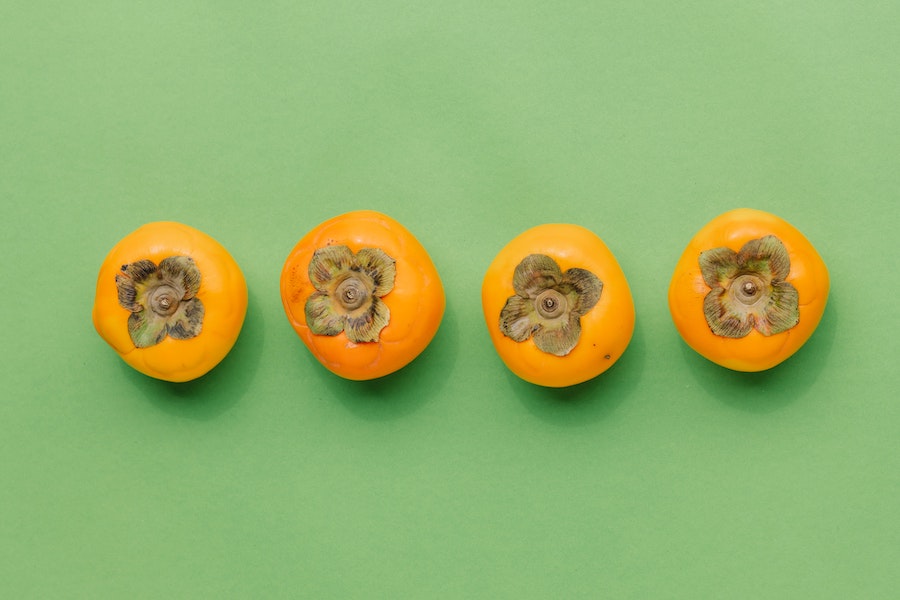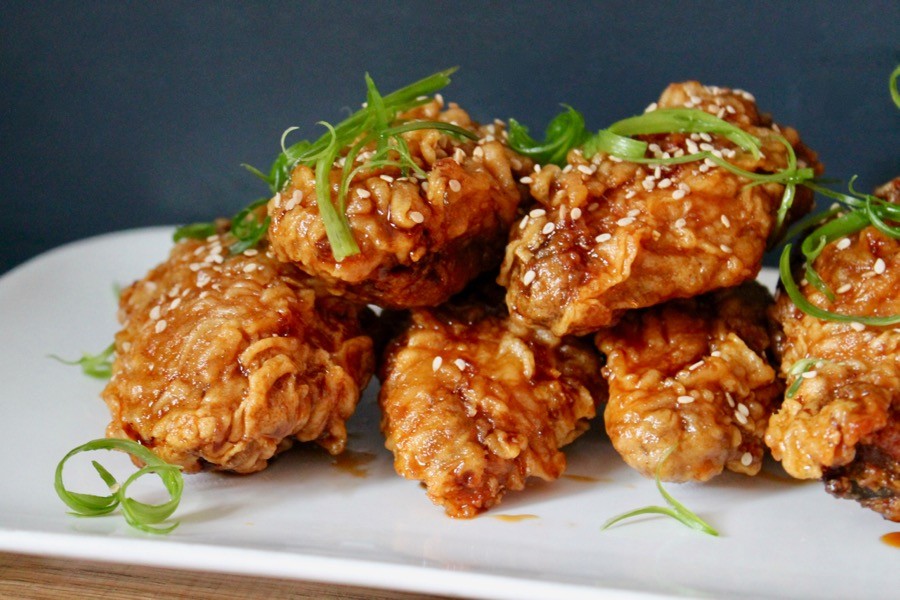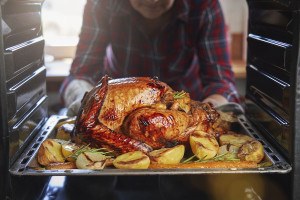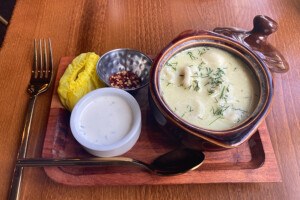The Myth of the Authentic Chef
What we mean when we designate restaurants and dishes as authentic, and how that language limits Philly's talented chefs.

Photograph by Any Lane
“I’m missing a connection to you. … ”
“[I don’t see] her Korean American roots. … ”
“She was scared. … ”
These were the judges’ comments about my first-round appetizer when I appeared on the Food Network’s Chopped almost 10 years ago. I would eventually emerge victorious — only after I added Korean elements to my entrée and fate handed me a South Korean favorite, the persimmon, in the dessert round.
Ask anyone who knows me well, and they’ll tell you I’m a proud Korean American chef (and that I’m rarely scared, by the way). But must I always cook Korean food to be successful, like the judges on Chopped not so subtly wanted me to?
My parents were both born and raised in South Korea and emigrated to Philadelphia in the late 1970s. I was born in Philly and spent most of my childhood in the suburbs, enjoying homemade kimchi, seolleongtang and freshly steamed rice. Inside our home kitchen, everything was Korean — at least, compared to the glimpses of food I saw when visiting friends’ homes or going out to eat.
When I was going into my junior year of high school, I traveled to South Korea for a summer program at Kyung Hee University. My parents wanted to visit our family there and make sure I had an immersive cultural experience. One of our instructors at Kyung Hee said that as Korean Americans, we were seen as American in South Korea but Korean in America. In his words, we were an identity crisis because we didn’t really fit in anywhere.
After my Chopped victory, my cousin’s childhood bestie reached out to see if I was interested in helping her husband open a new Korean gastropub in Philadelphia, SouthGate. The menu I developed featured Korean chicken wings, dolsot bibimbap and kimchi while also including more modernized takes on Korean flavors, like the bulgogi burger and soy-glazed pork belly and sweet potato ho bbang. I was proud of the menu. One of my bartenders remarked that of all the restaurants she had opened, she had never seen an opening menu so well received.

Southgate interior / Photograph by Aaron Hernandez
Of course, SouthGate is one of many Korean restaurants in Philly. Today, we’re fortunate that Philadelphians of all backgrounds can enjoy a huge variety of Korean dishes with relative ease — not just in this city, but all over the country. Diners study menus with feverish intensity; they cling to chef bios and food websites to find intel on where to get the best soon dubu chigae, which H Mart has the best food court, or what fruit you should add to your Korean BBQ marinade. (I’m a huge fan of Asian pear myself, by the way.) I love seeing the astronomical rise of Maangchi on YouTube. But the irony of this heightened awareness of Korean food and culture is that it can limit what’s considered permissible for Korean chefs to cook.
At SouthGate, no menu I developed could possibly satisfy every customer’s version of what Korean food “should” be. To some critics, the menu as a whole wasn’t considered Korean enough because it didn’t “bring serious heat” with dishes like nakji bokkeum, or because I’d dialed the “funk and spice” back too much by cooking crowd-pleasers like Korean BBQ tacos. On Yelp, there were more than a few “My grandmother makes better” remarks. At the same time, diners told me they were anti-soy, anti-ginger and anti-garlic, making it unfeasible for them to find something on the menu. Yet to those who couldn’t handle any heat, some of my sauces were a bit too spicy. So here I was, again, not Korean enough for some Yelp reviewers and food writers and too Korean for those unfamiliar with certain aspects of the cuisine.
Saying that Korean food is only hot and funky is like drawing a map of the United States with just New England. You’re missing most of the picture. The food culture of South Korea is vast. When my family travels there, we enjoy dozens of kinds of banchan, freshly slaughtered chicken soups, cold buckwheat noodles, blood sausage, mung bean pancakes, raw fish over steamed rice with vinegared gochujang sauce, and, of course, kalbi. And that’s just the beginning. The “Seoul” episode of Somebody Feed Phil covers a wide variety of Korean cuisine — including North Korean cuisine, which was a complete mystery to me.
My food isn’t considered “authentic Korean” by some because it doesn’t meet their myopic view of Korean food. Some only equate the cuisine with chilies and garlic. Many don’t know about the myriad noodle dishes, including kalguksu or bibim naengmyun. Or take maneuljjong jjangachi, for example: a delicious banchan that involves pickling the chef-darling ingredient garlic scapes and a sweet, tangy sauce. I never knew what this ingredient was called in English until I started working in restaurant kitchens. Korean food culture (and pretty much every other food culture) has so much to offer the dining public. It’s not only spicy and funky. Even when you look at one specific category like kimchi, you’ll discover there are hundreds of different kinds — and not all of them are spicy or dyed red with gochukaru.
The experience I had when I was the chef at SouthGate wasn’t unusual. Most chefs I know have fought this same uphill battle. When you’re tasked with representing a certain country’s cuisine by virtue of the menu or your appearance or lineage, everyone will have an opinion about how authentic your food is — even when there’s no consensus about what makes that cuisine authentic in the first place. A chef friend of mine commented that people saying food is or isn’t authentic begged the question: authentic to what?

Fried chicken at SouthGate / Photograph by Bondfire Media
As a Korean American chef, I can cook beyond kimchi and kalbi. One of the best parts about being a chef is unleashing my creativity in the kitchen. I love rolling out fresh pasta, a skill I learned from Italian American chefs while working in Italian restaurants. I don’t claim to make the best pasta in the world or assert that my way of doing it is any better than the centuries-old traditions. In my view, it’s rarely a bad idea to try to cook something from a different culture as long as you’re doing so with respect. Take the time to learn as much as you can about the food you’re making. Read cookbooks, talk with chefs, talk with friends, do your homework. A great litmus test for whether you’re being respectful of a culture or not is to imagine serving your food to a room full of grandmas from that country. Are you proud of your food? Or are you cringing at the thought of serving them? I once served chocolate mousse to a Frenchman in France and he swooned. It brought a tear to my eye.
As I write this and look back on some of the highlights of my career, they’re almost all tied to Korean cooking. My bulgogi burger won “Best of Philly” from this very magazine in 2016. I was able to meet one of my heroes, Anthony Bourdain, because he needed a Korean translator and cultural guide at a raw Korean seafood restaurant in Queens. I helped develop a Korean-fried-chicken-inspired drumstick for Questlove that was mentioned as one of the most delicious things to eat by Bon Appétit magazine. I am proud to be Korean American but want to be defined by more than just my cultural background. The famous chef André Soltner said, “One must cook a piece of meat one thousand times before one begins to truly understand it.” Preach, chef. We need to keep cooking and eating as many different foods as we can, as often as we can, to truly understand them.
Living in a city like Philly allows us access to hundreds of different restaurants, markets, chefs, food personalities and cultural resources. But for the city’s restaurant scene to fully thrive, we must also allow cooks — both professional and otherwise — to explore the many different food cultures of the world without any prejudice or pigeonholing. Philadelphia is in a unique position to usher in a new era of culinary freedom in which chefs can combine flavors, cultures and techniques in their cooking in a novel way. I know the talented chefs of the city can come up with innovative and delicious dishes the likes of which we’ve never seen before. Let’s forget about the myth of authenticity and let them.


